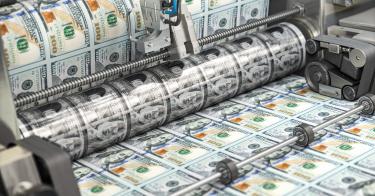Did greedy grocers and grabby workers cause the inflation?
That’s what the central bankers of the world would have us believe. Apparently losing confidence that they can fix the inflation they created, they’re turning to Plan B: blame the people, so we fight each other.
As the European Central Bank succinctly put it on Twitter: “What really drives inflation? Profits or wages?”
Get it, voter? Is it the greedy right-wing capitalists or the greedy left-wing socialists?
Central bankers actually have a name for this scapegoating: “greedflation.” As in, double-digit inflation had nothing to do with central bankers printing up $7 trillion and handing it to governments, bankers and to the rich in asset purchases. Rather, it all happened because people like you and me suddenly got greedy.
>>> How Bidenomics Is Quietly Robbing You Blind
In fact, something sudden did happen: By early 2022 one of every three dollars in existence had been printed in just two years. For centuries, economists have known that reckless money printing causes inflation. And that inflation then causes higher prices, higher paper profits and higher paper wages.
Since the beginning of our current inflation, corporate profits have taken the brunt of this scapegoating. By mid-2022, annual pre-tax corporate profits were up roughly 50%—$1.1 trillion—compared to pre-pandemic. Socialist politicians like Elizabeth Warren seized on this to accuse companies of causing inflation, bizarrely singling out grocery stores, one of the lowest margin businesses in the world.
Workers got a free pass, partly because real wages have fallen dramatically since Biden took office, summing to a cumulative 10% drop. But now that workers are finally getting pay raises as the money printing trickles down to them, they are joining the naughty list as “wageflation” becomes the scapegoat du jour.
We can understand why central bankers want to blame companies or workers, but let’s play along and ask: Do profits and wages cause inflation?
In short, no: It's the opposite. Inflation causes phantom profits for three reasons: too much money chasing too few goods; how accounting rules handle inflation; and economic uncertainty cutting investment. And when the money printing trickles down to workers, they catch up, as they are glacially doing now.
Starting with the money printing, during the pandemic the Fed printed roughly $7 trillion in new money to finance deficits to buy lockdowns. This occurred even as those same lockdowns were reducing the amount of stuff for sale; supply chains were choked, and services were literally closed.
Too much money chasing too few goods means more dollars per remaining good. In the kingdom of too much money and not enough production, the one-eyed factory is king.
Next up is accounting. Inventory is by definition bought in the past—meaning it cost the old pre-inflation price. Say your haberdashery buys hats for $9 and sells them for $10—you make a buck. If all prices go up 10%, last year’s $9 hats go for $11—your profits doubled. But you’re no healthier as a business: Every hat sold has to be restocked at $10 now—you still only make a buck. But you get a one-time profit on old, cheap inventory. It's an accounting quirk, not some nefarious shift of the economy toward Big Sneaker.
>>> The Decline and Fall of the U.S. Dollar
The final part is uncertainty. If a recession is on the horizon—or, say, a lockdown of half the economy—businesses pause investing because they're trying to survive. They don't replace machines or invest in advertising.
This cuts their costs in the moment—which raises paper profits. But, of course, it sacrifices future growth.
In fact, early on in the COVID pandemic, investment plunged by 22%. While investment did rise in 2021 as the economy first stepped out of lockdowns, recently it’s been crawling along at just over 1%, boosting paper profits even as the one-time accounting and supply chain effects fade.
So put it together and rising corporate profits these past three years have been a result, not a cause, of money printing paired with economic uncertainty. Both made in Washington, and both ongoing. While wages are only now beginning to catch up to prices.
Governments love to scapegoat the people for their screw-ups. Because getting half the country to blame the other half lets them off scot-free so they can get back to fleecing and impoverishing us while we fight.
It's enough to make you wonder if maybe Americans aren't actually at each other’s throats. That perhaps both sides agree that the system is broken, but that our elite does everything possible to set us against one another.
This piece originally appeared in MSN



